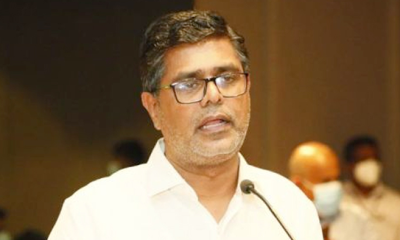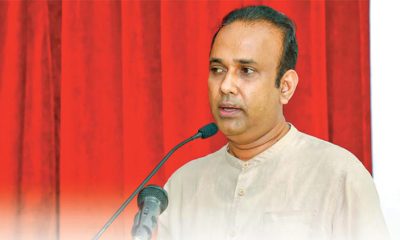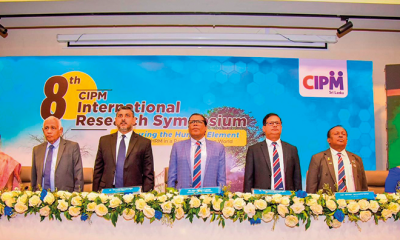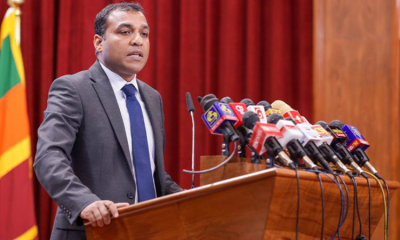Features
What makes a ‘knowledge centre’?

By Usvatte-aratchi
A translation of an essay written by Professor Sirimal Abeyratne (Colombo) appeared in the Lankadeepa of 18 August, 2021. As I have difficulties obtaining typescripts in Sinhala, I will write in English. Abeyratne dwelt on two questions. First, who benefits from ‘free education’? Second, how do you engineer a knowledge centre?
Prior to answering the first question, he forays briefly into discussing ‘what is free education’. As we have developed the usage, free education is what is free to the student or her parents. But the community as a whole, that includes you and me, pays for ‘free education’. Education is provided by the state. The state, unless you are Hegelian, is the community organised for political purposes. In order to pay for my education, the state using its agent the government, collects taxes from my parents. Instead of paying fees to a private school to educate me, my parents pay taxes to the government which pays the public schools to educate me. No matter who organises the provision of education, my parents pay for my education. However, there is a difference of critical importance of who actually pays for my schooling. When it is necessary that students or their parents pay for a child’s education, whether a child goes to school depends on whether parents can afford to pay for the child’s education. When the community pays for children’s education, the child can go to school, no matter whether his parents have the wherewithal to pay for his education. The rest of the community takes on that burden. This is fairer, far more just and far more productive for social wellbeing. Education is free in school and in university in the same sense as it is in Sri Lanka in France, Germany and Finland and may be elsewhere. In the US, primary and secondary education is free in the same sense. We are in no sense unique.
US school education
In the US, school education (K-12) is organised by School Boards, elected by voters in the School Board area. School Boards pay for education with property taxes paid by owners in the area. The Board is accountable to those that elected them, by and large, the same persons who pay property taxes: an excellent example of the principle of subsidiarity at work. Parents are commonly closely associated with the school. One of them may volunteer to substitute for a teacher absent without expectation, another may help in the library and still another may accompany a class on a day-outing. That gives a clue to the differentiating in the quality of teaching in schools. The more educated and the better informed the parents are, the better their schools. Imagine a young couple who have come out of an elite university and together earn $100,000 to $200,000 a month. They can buy an expensive house in a School Board area (e.g. Montgomery County in Virginia), where public schools are of high quality. In New York City, Brooklyn High School, Bronx High School and Manhattan Science High School, all in the public sector, have excellent reputations. The high prices of houses will keep out those with low incomes. (The State of California introduced, a few years ago, a scheme to make equalisation grants to improve the quality of education in poorer counties.) The parents will take care to provide a home environment conducive to creative activity and the growth of the children’s minds. Besides, they can buy private tuition to supplement what is done in excellent schools. Parents will take the children to see the beauty of the country, to great museums, to enjoy a play and in summer perhaps to Italy, to China, to India or to Japan. The children will learn at least one foreign language (perhaps Greek or Latin, in addition), some music, to dance, play baseball and to debate. Their teachers, counsellors and parents will be aware of what elite college admission committees look for and send the children to volunteer work in a hospital or the local library. In these and many other ways children from educated and high earning families will ‘hoard the dreams’ of children of common families. Contrast that with the experience of poorly educated and low-income families whose children may never have been out of their hometowns, never seen a museum or even seen even the ocean, if in Iowa or Idaho. That pattern, on a lower scale, is quite common in our country. I had not been to Galle till I was 15 when I was hospitalised there for three nights. (I was shocked to hear from a ward doctor in a private hospital in Colombo, who normally worked in a government hospital, that he, although owning a car, had never been to Matara or to Nuwara- Eliya. He had gone to school in Veyangoda.) Given these wide disparities in income levels, educational levels and cultural practices among families, it is utopian to imagine that there are equal opportunities for all children to do well in school and in university. We can observe these differences played out in daily lives. How many physicians or surgeons have you met in this country, whose parents were tea pluckers in the hill country? Even as early as the 5th standard scholarship examination, you can see children whose parents earn regular incomes, commonly from government, end up in the top one or two percent of high scorers. Look at sharp differences of those who score high Z scores at A’Level in Mullaitivu and in Gampaha districts. There are odd instances when an extraordinarily intelligent student may break these barriers. But they are exceptional and prove the rule. In China, the same result is achieved with the hukou system and competition at gaokao, the entrance examination to universities. The $70 billion private tuition industry, now under attack there, is stark evidence of differences in the capacity between the rich and the poor to buy ‘good education’. In Colombo, you can see the same schemes at work through property prices. Borella, Maradana, Kurunduvatta, Bambalapitiya and Kollupitiya have nests of high-quality schools which feed into the more coveted faculties in selected universities. You can observe that even those who score high at Grade V scholarship examination are from families where parents have had more education in them than others. Given even the best intentions (e.g. China), there is no way that advantages enjoyed by children from families of well-educated parents, who almost invariably earn high and stable incomes, can be denied advantages in education.
Creating knowledge centers
Let us briefly, look at the idea of creating ‘knowledge centres’ that Abeyratne wrote abut. The presence of foreign students and teachers is not always a mark of a knowledge centre. There are a large number of foreign students in both China and India, although neither is yet known as a knowledge centre. A country may have a large number of foreigners as teachers, simply because it is short of competent teachers. In Peradeniya in the 1950s, the professor of Samskrt was German, four teachers in economics (Das Gupta, Sarkar, Oliver Henry and Eiteman) were from overseas, in history two and one each in Sociology, Geography and English.) Gradually local scholars replaced them. Abeyratne, in fact, was looking for students and teachers who are attracted by leading scholars in particular disciplines, who open up new lines of inquiry that may extend the width and depth of that discipline and well-functioning labs working on frontier problems in a particular discipline. In the University of Cambridge in 1989-90, out of 10,243 undergraduates, 568 or about 5% were overseas students and of 2,975 postgraduate students 1,022 or about a third from overseas. In the History Faculty in the same year, out of 60 postgraduate students admitted, 33 or more than a half were from overseas. The reputation of good scholars matters much.
Importance of libraries
The importance of libraries, especially for undergraduates has diminished somewhat with computer technology, but not entirely. For research students a great library is an essential asset. A reputation for good research is earned with publications in high quality journals and books that explore new areas or develop new insights into existing problems. That in turn implies that there are good publishing houses. University Presses are essential ingredients for ‘knowledge centres’. The Cambridge University Press comes from 1534 CE and Oxford UP from 1536. There is not a single good publishing house in our country. Good research comes out of universities with strong leaders in certain disciplines. This was most clearly evident in German universities from about 1850 to the disaster that was Hitler. This practice of powerful professors who assembled a number of researchers started in mid-nineteenth century Germany, soon spread to Britain and the US. In US, the outstanding example is Johns Hopkins in Baltimore. The expulsion of Jewish university teachers and researchers in the 1930s from Germany by Hitler and their dispersal in Britain and the US helped greatly to promote research in many disciplines in those countries: mathematics, physics, linguistics and sociology. Amsterdam, Utrecht and London had had great publishing houses from the 17th century, when dissenters of various kinds fled their home cities in search of welcoming havens: e.g. Benedictus Spinoza from Madrid, John Locke and James Mill from London.
Instance of our failure
An instance where we failed to make use of strong leaders in anthropology to establish a centre for the study of societies in South Asia was in Peradeniya in the 1950s. The leaders were Ralph Peiris, Stanley Tambiah, Gananath Obeysekera, Kitsiri Malalgoda and H. L. Seneviratne, all distinguished anthropologists. A younger scholar Sarath Amunugama joined the Civil Service. In addition, there were Michael Roberts in History and K. N. O. Dharmadasa in Sinhala, both of whom had made contributions to anthropology. They all, except KNO, dispersed themselves to more welcome homes in the US, New Zealand and Australia. Some distinguished scientists dispersed to Britain, the US, Canada and Hong Kong. There is a centripetal force at work here, without destroying which, it is unlikely that we will develop a knowledge centre in our country.
I would rather emphasise the development of good undergraduate schools from which may grow graduate schools, as was emanant in the late 1950s in the University of Ceylon but was aborted by ill-informed judgement on the development of higher education. The present ill-founded emphasis on ‘discipline’ in universities would welcome a worse disaster. The memory of Hitler destroying German universities 1930s has not been erased from our memories.
(This is the last of three notes I wrote on university matters in August, during the worst days of the epidemic in our country. It helped me to keep my mind off impending horrors. Then, our son came home spreading sunshine for a brief two weeks.)
Features
The heart-friendly health minister

by Dr Gotabhya Ranasinghe
Senior Consultant Cardiologist
National Hospital Sri Lanka
When we sought a meeting with Hon Dr. Ramesh Pathirana, Minister of Health, he graciously cleared his busy schedule to accommodate us. Renowned for his attentive listening and deep understanding, Minister Pathirana is dedicated to advancing the health sector. His openness and transparency exemplify the qualities of an exemplary politician and minister.
Dr. Palitha Mahipala, the current Health Secretary, demonstrates both commendable enthusiasm and unwavering support. This combination of attributes makes him a highly compatible colleague for the esteemed Minister of Health.
Our discussion centered on a project that has been in the works for the past 30 years, one that no other minister had managed to advance.
Minister Pathirana, however, recognized the project’s significance and its potential to revolutionize care for heart patients.
The project involves the construction of a state-of-the-art facility at the premises of the National Hospital Colombo. The project’s location within the premises of the National Hospital underscores its importance and relevance to the healthcare infrastructure of the nation.
This facility will include a cardiology building and a tertiary care center, equipped with the latest technology to handle and treat all types of heart-related conditions and surgeries.
Securing funding was a major milestone for this initiative. Minister Pathirana successfully obtained approval for a $40 billion loan from the Asian Development Bank. With the funding in place, the foundation stone is scheduled to be laid in September this year, and construction will begin in January 2025.
This project guarantees a consistent and uninterrupted supply of stents and related medications for heart patients. As a result, patients will have timely access to essential medical supplies during their treatment and recovery. By securing these critical resources, the project aims to enhance patient outcomes, minimize treatment delays, and maintain the highest standards of cardiac care.
Upon its fruition, this monumental building will serve as a beacon of hope and healing, symbolizing the unwavering dedication to improving patient outcomes and fostering a healthier society.We anticipate a future marked by significant progress and positive outcomes in Sri Lanka’s cardiovascular treatment landscape within the foreseeable timeframe.
Features
A LOVING TRIBUTE TO JESUIT FR. ALOYSIUS PIERIS ON HIS 90th BIRTHDAY

by Fr. Emmanuel Fernando, OMI
Jesuit Fr. Aloysius Pieris (affectionately called Fr. Aloy) celebrated his 90th birthday on April 9, 2024 and I, as the editor of our Oblate Journal, THE MISSIONARY OBLATE had gone to press by that time. Immediately I decided to publish an article, appreciating the untiring selfless services he continues to offer for inter-Faith dialogue, the renewal of the Catholic Church, his concern for the poor and the suffering Sri Lankan masses and to me, the present writer.
It was in 1988, when I was appointed Director of the Oblate Scholastics at Ampitiya by the then Oblate Provincial Fr. Anselm Silva, that I came to know Fr. Aloy more closely. Knowing well his expertise in matters spiritual, theological, Indological and pastoral, and with the collaborative spirit of my companion-formators, our Oblate Scholastics were sent to Tulana, the Research and Encounter Centre, Kelaniya, of which he is the Founder-Director, for ‘exposure-programmes’ on matters spiritual, biblical, theological and pastoral. Some of these dimensions according to my view and that of my companion-formators, were not available at the National Seminary, Ampitiya.
Ever since that time, our Oblate formators/ accompaniers at the Oblate Scholasticate, Ampitiya , have continued to send our Oblate Scholastics to Tulana Centre for deepening their insights and convictions regarding matters needed to serve the people in today’s context. Fr. Aloy also had tried very enthusiastically with the Oblate team headed by Frs. Oswald Firth and Clement Waidyasekara to begin a Theologate, directed by the Religious Congregations in Sri Lanka, for the contextual formation/ accompaniment of their members. It should very well be a desired goal of the Leaders / Provincials of the Religious Congregations.
Besides being a formator/accompanier at the Oblate Scholasticate, I was entrusted also with the task of editing and publishing our Oblate journal, ‘The Missionary Oblate’. To maintain the quality of the journal I continue to depend on Fr. Aloy for his thought-provoking and stimulating articles on Biblical Spirituality, Biblical Theology and Ecclesiology. I am very grateful to him for his generous assistance. Of late, his writings on renewal of the Church, initiated by Pope St. John XX111 and continued by Pope Francis through the Synodal path, published in our Oblate journal, enable our readers to focus their attention also on the needed renewal in the Catholic Church in Sri Lanka. Fr. Aloy appreciated very much the Synodal path adopted by the Jesuit Pope Francis for the renewal of the Church, rooted very much on prayerful discernment. In my Religious and presbyteral life, Fr.Aloy continues to be my spiritual animator / guide and ongoing formator / acccompanier.
Fr. Aloysius Pieris, BA Hons (Lond), LPh (SHC, India), STL (PFT, Naples), PhD (SLU/VC), ThD (Tilburg), D.Ltt (KU), has been one of the eminent Asian theologians well recognized internationally and one who has lectured and held visiting chairs in many universities both in the West and in the East. Many members of Religious Congregations from Asian countries have benefited from his lectures and guidance in the East Asian Pastoral Institute (EAPI) in Manila, Philippines. He had been a Theologian consulted by the Federation of Asian Bishops’ Conferences for many years. During his professorship at the Gregorian University in Rome, he was called to be a member of a special group of advisers on other religions consulted by Pope Paul VI.
Fr. Aloy is the author of more than 30 books and well over 500 Research Papers. Some of his books and articles have been translated and published in several countries. Among those books, one can find the following: 1) The Genesis of an Asian Theology of Liberation (An Autobiographical Excursus on the Art of Theologising in Asia, 2) An Asian Theology of Liberation, 3) Providential Timeliness of Vatican 11 (a long-overdue halt to a scandalous millennium, 4) Give Vatican 11 a chance, 5) Leadership in the Church, 6) Relishing our faith in working for justice (Themes for study and discussion), 7) A Message meant mainly, not exclusively for Jesuits (Background information necessary for helping Francis renew the Church), 8) Lent in Lanka (Reflections and Resolutions, 9) Love meets wisdom (A Christian Experience of Buddhism, 10) Fire and Water 11) God’s Reign for God’s poor, 12) Our Unhiddden Agenda (How we Jesuits work, pray and form our men). He is also the Editor of two journals, Vagdevi, Journal of Religious Reflection and Dialogue, New Series.
Fr. Aloy has a BA in Pali and Sanskrit from the University of London and a Ph.D in Buddhist Philosophy from the University of Sri Lankan, Vidyodaya Campus. On Nov. 23, 2019, he was awarded the prestigious honorary Doctorate of Literature (D.Litt) by the Chancellor of the University of Kelaniya, the Most Venerable Welamitiyawe Dharmakirthi Sri Kusala Dhamma Thera.
Fr. Aloy continues to be a promoter of Gospel values and virtues. Justice as a constitutive dimension of love and social concern for the downtrodden masses are very much noted in his life and work. He had very much appreciated the commitment of the late Fr. Joseph (Joe) Fernando, the National Director of the Social and Economic Centre (SEDEC) for the poor.
In Sri Lanka, a few religious Congregations – the Good Shepherd Sisters, the Christian Brothers, the Marist Brothers and the Oblates – have invited him to animate their members especially during their Provincial Congresses, Chapters and International Conferences. The mainline Christian Churches also have sought his advice and followed his seminars. I, for one, regret very much, that the Sri Lankan authorities of the Catholic Church –today’s Hierarchy—- have not sought Fr.
Aloy’s expertise for the renewal of the Catholic Church in Sri Lanka and thus have not benefited from the immense store of wisdom and insight that he can offer to our local Church while the Sri Lankan bishops who governed the Catholic church in the immediate aftermath of the Second Vatican Council (Edmund Fernando OMI, Anthony de Saram, Leo Nanayakkara OSB, Frank Marcus Fernando, Paul Perera,) visited him and consulted him on many matters. Among the Tamil Bishops, Bishop Rayappu Joseph was keeping close contact with him and Bishop J. Deogupillai hosted him and his team visiting him after the horrible Black July massacre of Tamils.
Features
A fairy tale, success or debacle

Sri Lanka-Singapore Free Trade Agreement
By Gomi Senadhira
senadhiragomi@gmail.com
“You might tell fairy tales, but the progress of a country cannot be achieved through such narratives. A country cannot be developed by making false promises. The country moved backward because of the electoral promises made by political parties throughout time. We have witnessed that the ultimate result of this is the country becoming bankrupt. Unfortunately, many segments of the population have not come to realize this yet.” – President Ranil Wickremesinghe, 2024 Budget speech
Any Sri Lankan would agree with the above words of President Wickremesinghe on the false promises our politicians and officials make and the fairy tales they narrate which bankrupted this country. So, to understand this, let’s look at one such fairy tale with lots of false promises; Ranil Wickremesinghe’s greatest achievement in the area of international trade and investment promotion during the Yahapalana period, Sri Lanka-Singapore Free Trade Agreement (SLSFTA).
It is appropriate and timely to do it now as Finance Minister Wickremesinghe has just presented to parliament a bill on the National Policy on Economic Transformation which includes the establishment of an Office for International Trade and the Sri Lanka Institute of Economics and International Trade.
Was SLSFTA a “Cleverly negotiated Free Trade Agreement” as stated by the (former) Minister of Development Strategies and International Trade Malik Samarawickrama during the Parliamentary Debate on the SLSFTA in July 2018, or a colossal blunder covered up with lies, false promises, and fairy tales? After SLSFTA was signed there were a number of fairy tales published on this agreement by the Ministry of Development Strategies and International, Institute of Policy Studies, and others.
However, for this article, I would like to limit my comments to the speech by Minister Samarawickrama during the Parliamentary Debate, and the two most important areas in the agreement which were covered up with lies, fairy tales, and false promises, namely: revenue loss for Sri Lanka and Investment from Singapore. On the other important area, “Waste products dumping” I do not want to comment here as I have written extensively on the issue.
1. The revenue loss
During the Parliamentary Debate in July 2018, Minister Samarawickrama stated “…. let me reiterate that this FTA with Singapore has been very cleverly negotiated by us…. The liberalisation programme under this FTA has been carefully designed to have the least impact on domestic industry and revenue collection. We have included all revenue sensitive items in the negative list of items which will not be subject to removal of tariff. Therefore, 97.8% revenue from Customs duty is protected. Our tariff liberalisation will take place over a period of 12-15 years! In fact, the revenue earned through tariffs on goods imported from Singapore last year was Rs. 35 billion.
The revenue loss for over the next 15 years due to the FTA is only Rs. 733 million– which when annualised, on average, is just Rs. 51 million. That is just 0.14% per year! So anyone who claims the Singapore FTA causes revenue loss to the Government cannot do basic arithmetic! Mr. Speaker, in conclusion, I call on my fellow members of this House – don’t mislead the public with baseless criticism that is not grounded in facts. Don’t look at petty politics and use these issues for your own political survival.”
I was surprised to read the minister’s speech because an article published in January 2018 in “The Straits Times“, based on information released by the Singaporean Negotiators stated, “…. With the FTA, tariff savings for Singapore exports are estimated to hit $10 million annually“.
As the annual tariff savings (that is the revenue loss for Sri Lanka) calculated by the Singaporean Negotiators, Singaporean $ 10 million (Sri Lankan rupees 1,200 million in 2018) was way above the rupees’ 733 million revenue loss for 15 years estimated by the Sri Lankan negotiators, it was clear to any observer that one of the parties to the agreement had not done the basic arithmetic!
Six years later, according to a report published by “The Morning” newspaper, speaking at the Committee on Public Finance (COPF) on 7th May 2024, Mr Samarawickrama’s chief trade negotiator K.J. Weerasinghehad had admitted “…. that forecasted revenue loss for the Government of Sri Lanka through the Singapore FTA is Rs. 450 million in 2023 and Rs. 1.3 billion in 2024.”
If these numbers are correct, as tariff liberalisation under the SLSFTA has just started, we will pass Rs 2 billion very soon. Then, the question is how Sri Lanka’s trade negotiators made such a colossal blunder. Didn’t they do their basic arithmetic? If they didn’t know how to do basic arithmetic they should have at least done their basic readings. For example, the headline of the article published in The Straits Times in January 2018 was “Singapore, Sri Lanka sign FTA, annual savings of $10m expected”.
Anyway, as Sri Lanka’s chief negotiator reiterated at the COPF meeting that “…. since 99% of the tariffs in Singapore have zero rates of duty, Sri Lanka has agreed on 80% tariff liberalisation over a period of 15 years while expecting Singapore investments to address the imbalance in trade,” let’s turn towards investment.
Investment from Singapore
In July 2018, speaking during the Parliamentary Debate on the FTA this is what Minister Malik Samarawickrama stated on investment from Singapore, “Already, thanks to this FTA, in just the past two-and-a-half months since the agreement came into effect we have received a proposal from Singapore for investment amounting to $ 14.8 billion in an oil refinery for export of petroleum products. In addition, we have proposals for a steel manufacturing plant for exports ($ 1 billion investment), flour milling plant ($ 50 million), sugar refinery ($ 200 million). This adds up to more than $ 16.05 billion in the pipeline on these projects alone.
And all of these projects will create thousands of more jobs for our people. In principle approval has already been granted by the BOI and the investors are awaiting the release of land the environmental approvals to commence the project.
I request the Opposition and those with vested interests to change their narrow-minded thinking and join us to develop our country. We must always look at what is best for the whole community, not just the few who may oppose. We owe it to our people to courageously take decisions that will change their lives for the better.”
According to the media report I quoted earlier, speaking at the Committee on Public Finance (COPF) Chief Negotiator Weerasinghe has admitted that Sri Lanka was not happy with overall Singapore investments that have come in the past few years in return for the trade liberalisation under the Singapore-Sri Lanka Free Trade Agreement. He has added that between 2021 and 2023 the total investment from Singapore had been around $162 million!
What happened to those projects worth $16 billion negotiated, thanks to the SLSFTA, in just the two-and-a-half months after the agreement came into effect and approved by the BOI? I do not know about the steel manufacturing plant for exports ($ 1 billion investment), flour milling plant ($ 50 million) and sugar refinery ($ 200 million).
However, story of the multibillion-dollar investment in the Petroleum Refinery unfolded in a manner that would qualify it as the best fairy tale with false promises presented by our politicians and the officials, prior to 2019 elections.
Though many Sri Lankans got to know, through the media which repeatedly highlighted a plethora of issues surrounding the project and the questionable credentials of the Singaporean investor, the construction work on the Mirrijiwela Oil Refinery along with the cement factory began on the24th of March 2019 with a bang and Minister Ranil Wickremesinghe and his ministers along with the foreign and local dignitaries laid the foundation stones.
That was few months before the 2019 Presidential elections. Inaugurating the construction work Prime Minister Ranil Wickremesinghe said the projects will create thousands of job opportunities in the area and surrounding districts.
The oil refinery, which was to be built over 200 acres of land, with the capacity to refine 200,000 barrels of crude oil per day, was to generate US$7 billion of exports and create 1,500 direct and 3,000 indirect jobs. The construction of the refinery was to be completed in 44 months. Four years later, in August 2023 the Cabinet of Ministers approved the proposal presented by President Ranil Wickremesinghe to cancel the agreement with the investors of the refinery as the project has not been implemented! Can they explain to the country how much money was wasted to produce that fairy tale?
It is obvious that the President, ministers, and officials had made huge blunders and had deliberately misled the public and the parliament on the revenue loss and potential investment from SLSFTA with fairy tales and false promises.
As the president himself said, a country cannot be developed by making false promises or with fairy tales and these false promises and fairy tales had bankrupted the country. “Unfortunately, many segments of the population have not come to realize this yet”.
(The writer, a specialist and an activist on trade and development issues . )





















